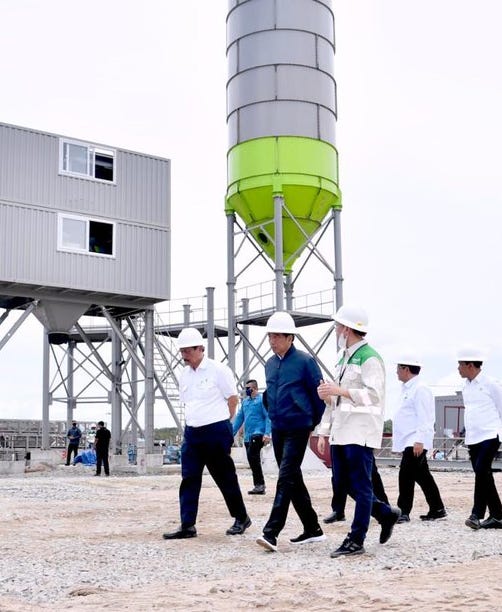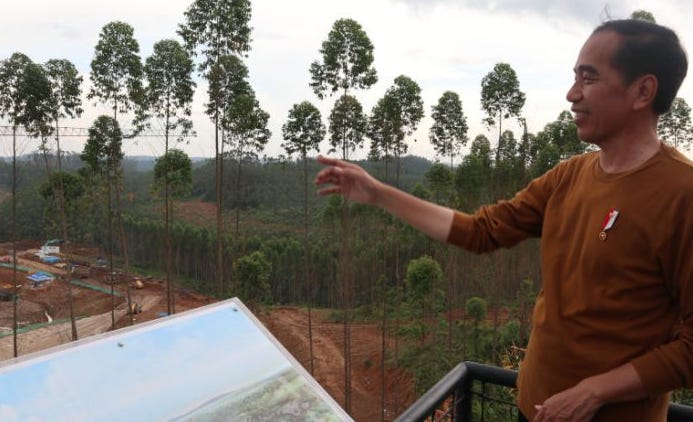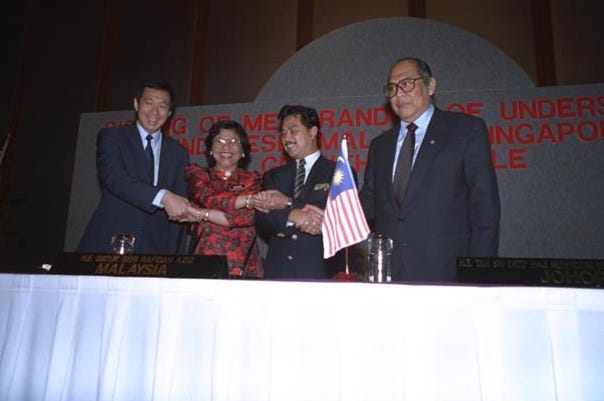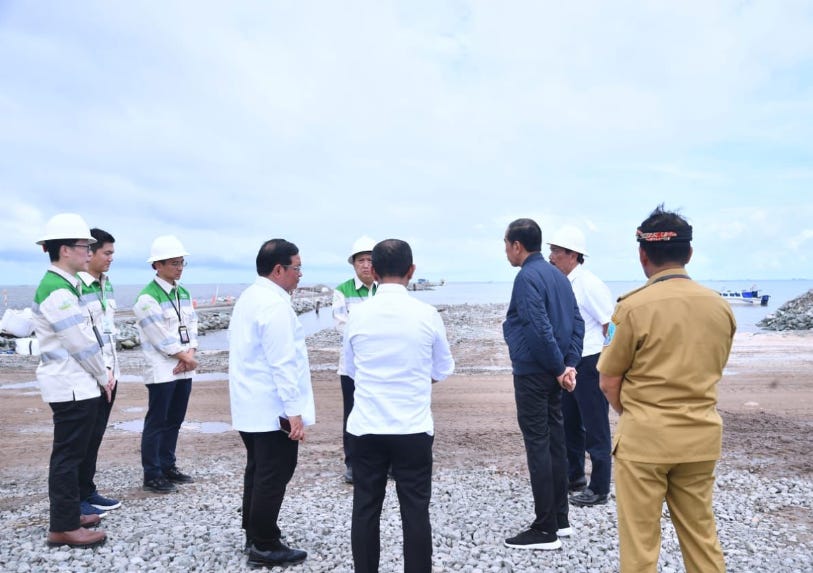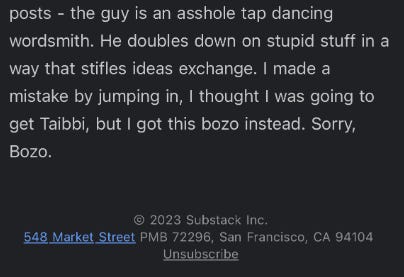President Joko Widodo (Jokowi) along with his entourage visited and reviewed the readiness of the Kalimantan Industrial Park Indonesia (KIPI) in Bulungan District, North Kalimantan, on Tuesday (Feb 28th).
"This afternoon, I am following up the readiness of the Bulungan, because this is a long - giant leapfrog in the future of Indonesia," the president stated.
Jokowi was accompanied by public works and Investment - Maritime minister Luhut, also Garibaldi Thohir, siblings of Minister SOE Erick Thohir.
Similar Jakarta - Jababeka Industrial Park, KIPI not too far from the new capital city of Indonesia (named NUSANTARA, in Penajam Paser), only around 400 km. Indonesia followed a similar decision like South Korea which has a capital city (Seoul) with futuristic-integrated industrial park Songdo (40 km).
Jokowi urged that the area be utilized in the near future and that the project absorb as much (gargantuan) manpower as possible.
"I really laud the initiative from the investors, capital owners, and CEOs, who have come and built their industry here," he said here on Tuesday.
Jokowi remarked that the government will start a transformation of the Indonesian economy. From relying on natural resources and raw material exports, the government has now decided to start the industrialization of raw materials. The president emphasized that Indonesia should start exporting semi-finished or finished goods.
"For North Kalimantan, almost all industry products are finished goods, so they are able to provide added value for our country, as we sell them in the form of finished goods," the President affirmed.
Jokowi called this effort (in KIPI and IKN NUSANTARA) a giant leap frog. In the next five to 10 years, the benefits of this program would have impacts on society and the government as well, he noted. After Palangkaraya by Soekarno (but failed), and SiJoRi (Singapore-Johor-Riau) in 1990s but failed because insufficient budget, this is (KIPI and IKN) momentum for Indonesia to sacrosanct “rowing between two rocks”. To decrease population in Java, Also to boost manufacturing, set a long-term from agricultural-reliant country (Indonesia is top 20 agricultural-reliant) to be newly industrialized country (NICs).
The Singapore-Johor-Riau (SIJORI) Growth Triangle was announced on 20 December 1989 by then First Deputy Prime Minister Goh Chok Tong, Indonesia’s (former) Trade Minister (the late) Arifin Siregar, and Malaysia’s Rafidah Aziz. It is a tripartite arrangement between Singapore, Johor (in Malaysia) and Riau (in Indonesia) that seeks to exploit the competitive strengths of the three areas, and make the sub-region more attractive to regional and international investors.
The growth triangle links the logistics, transportation and financial facilities of Singapore with the natural and labour resources of Johor and Riau The development of SIJORI is largely led by the private sector, with governments facilitating the flow of goods, services, investment and people. Deputy Prime Minister Brigadier-General Lee Hsien Loong and trade officials of Indonesia (Arifin Siregar) and Malaysia (Rafidah Aziz) sealing the Indonesia-Malaysia-Singapore Growth Triangle (IMS-GT) Memorandum of Understanding (MOU) during signing ceremony at Hyatt Regency, Johore Bahru.
The Singapore-Riau link has since emerged as the strongest leg of the growth triangle, with collaborative efforts leading to several new industrial parks, and resorts being established on the Indonesian islands of Batam, Bintan and Karimun. Both Bintan and Batam have become manufacturing bases for multi-national corporations from countries such as the US, the Netherlands, Taiwan, Japan, Panama, Australia and the Bahamas, as well as Singapore firms looking to reduce costs.While trade and industrial links between Singapore and Johor are also well established, the Johor-Riau link has not been as active owing to the lack of complementarity between the two regions.
Unfortunately, the 1997-1998 global financial crisis hammered Indonesia very deeply, so Batam failed to maximize its potential to be a new hub and or new industrial zone. Jokowi learned about it. Although gargantuan (predicted) US$ 220 billion to develop KIPI and IKN, he set a long term goal: reach every investor across the world, and he can't be stopped by coronavirus.
The president also urged ministers, governors, and regional heads to prepare human resources to support the industrial area.
"It is because this area requires human resources with good qualifications. Please prepare them for this," he added.
According to Jokowi, at least 100 thousand workers will be required for KIPI's construction period, and in the future may reach 1-2 million.
"During operations, we might need as many as 100 thousand workers. I estimate that the industries may absorb more than 300 thousand workers from their subsidiary companies. In the future, maybe a million" he emphasized.
The Green Industrial Park is an industrial area operating with clean technology and production.
The Indonesian Industrial Park in North Kalimantan, owned by PT Kalimantan Industrial Park Indonesia (KIPI) and PT Kawasan Industri Kalimantan Indonesia (KIKI), with a total area of 30 thousand hectares, is expected to be the largest industrial area in the world.
The industrial area will use new and renewable energy as the main energy source, two of which are hydropower and solar panels. In addition, electric power will be supported using gas fuel.
KIPI requires an investment of US$160 billion, or equivalent to around Rp2,100 trillion, for all stages of construction and commercialization for the next eight years. Combined with (gigantic) IKN NUSANTARA, Indonesia aim to set total US$210-220 billion between IKN and KIPI. The construction of the new capital city of IKN NUSANTARA, from the sheer cost of the project, estimated at US$55-60 billion, to its environmental impacts on the surrounding region.
Jokowi has expressed the hope that Indonesia’s Independence Day in 2024 (79 years of Independence), his final year of Presidency (ended officially )ct 19th 2024) will be commemorated in the future capital (IKN) NUSANTARA.
"This is the area (for the development) of the presidential palace, which, God willing, I am optimistic that the (Independence Day) ceremony in August next year will be held here," he said at the IKN’s Central Government Core Area (KIPP) on Thursday (Feb 24).
The cost may have ballooned, to build access transportation between KIPI and IKN. For example MRT Balaraja-Cikarang, 2 industrial parks in East and West Jakarta, not yet constructed and just a blueprint, wants Rp160 Trillion or US$ 10.4 billion. In the real situation, Jakarta workers mostly came from (housing) Serpong Integrated City (Indonesia: BSD, Bumi Serpong Damai), built in the 1980s with an aggregate US$ 13 billion worth, distance around 40 km from Presidential Palace Jakarta (Istana Merdeka). Another integrated city in Maja (10-11 thousand hectares), distance around 83 km from Presidential Palace Jakarta, with preliminary cost until now around US$ 1 billion.
KIPI’s Project funding is fully provided by the private sector without any guarantee from the government.
The selection of Kalimantan as the site for Indonesia’s new capital is also likely to facilitate increased foreign investment in the island, considering that Kalimantan’s natural resources are both lucrative and abundant. This can be seen in various projects involving investments from UAE, Europe, America, and China as well, including development projects in the energy sector.
The dream to “not be too reliant with Java” already started since (former) President Soekano, a Javanese, when built Palangkaraya in the 1950s-1960s, not only Jokowi’s dream. Jokowi also a Javanese.
The tiny island of Java, 158-160 million population out of (total) Indonesia population 275 million, has more population than all of Russia, more than all of Japan. By Asian standards, Java is just extremely densely populated. Java’s population density is 1,100 people per square km. This is 3x the density of Japan or the Philippines, 7x that of China, 30x that of the US. It’s nearly the density of Houston, Texas. For an entire island, with volcanoes. Compared to its big neighboring islands, it’s 8x more densely populated than Sumatra and 30x more than Borneo
Java was already very populated before the 1800s, thanks to several Hindu - Buddhism monarchs. The Indonesian government encourages a transmigration programme of settlers from heavily populated provinces (mostly from Java) to sparsely populated ones.
This has wreaked havoc on demographics of many provinces turning the natives into minorities in their own homes. Java produces 75% of Indonesia's rice. You can see the overlap between rice production regions and population density. The most common reason for “ultra - fertile” soil in Java is because volcanoes: volcanic soil is ultra - fertile. Indeed, you can see that Java is crowded except inside the volcanoes, which form holes in the night lights map.
A good chunk of it is andosols, which comes from the volcanoes, which means it’s young soil that hasn’t lost its nutrients through millions of years of leaching. That means it can support lots of crops for a long time. It also has luvisols and nitosols, both of which are fertile. Again, Javanese soil is ultra fertile / hyperfertile. Java has more active volcanoes. These volcanoes are so active that they spew ash, which is a great fertilizer. Being close to the equator means heat and rain, which is amazing for plants if your soil is recent, volcanic, hasn't leached for millions of years, and isn't inundated by swamps or seawater.
Javanese live everywhere but on volcanoes. These volcanoes are active, but they’re not covering the soil every few years with a new layer of lava. They erupt every few hundreds, thousands, or millions of years, and when they do, they don’t cover the regions where they are. Wouldn’t intensive agriculture exhaust them, the way farmers have to fallow ground after some harvests to let it build up its nutrients again?
More importantly, if this volcano thing were true, shouldn’t all the volcanic areas be fertile and sustain a big population? We’ve seen this isn’t true: Yes, Java, the Philippines, and Japan have plenty of volcanoes and big populations. But the Indonesian islands of Sumatra and the north of Sulawesi also have plenty of volcanoes, and have smaller populations. Since the very early Independence of Indonesia, the founding fathers of Indonesia have tried long-term planning to maximize potential “non Java” so Java is not facing overpopulation. WIth gigantic investment KIPI and IKN in Kalimantan, this is the long-term future of Indonesia, like Jokowi said.
Jokowi repeatedly denied that KIPI and IKN are “China-centric”, although distance Beijing to IKN is of course shorter than Beijing to Jakarta. Tomorrow, March 1st, 2023, Jokowi will open (to the public) the Masjid Zayed Nahyan in his hometown Solo. This Masjid/Mosque will be the signature of the massive relationship between Jakarta - Abu Dhabi, initially by Jokowi - ruler UAE Mohammed bin Zayed (MBZ). Jokowi is very special” for the Sultanate - Emir of United Arab Emirates MBZ. Jokowi’s grandson, namely “Nahyan”, to show Jokowi respect with UAE ruler Mohammed bin Zayed Al Nahyan.
Construction for the project is also targeted for completion in 2024, with the phased operations starting from this year (preliminary) and 2024 to 2029.
Several projects are planned to be built in the area, such as an aluminum smelter, petrochemicals, electronic aluminum, steel, new energy battery, industrial silicon, polycrystalline silicon, and solar panels.
KIPI is implemented through cooperation among Indonesia, China, and the United Arab Emirates.
——
-prada- (Adi Mulia Pradana) is a Helper. Former adviser (President Indonesia) Jokowi for mapping 2-times election. I used to get paid to catch all these blunders—now I do it for free. Trying to work out what's going on, what happens next. Arch enemies of the tobacco industry, (still) survive after getting doxed.
(Very rare compliment and initiative pledge. Thank you. Yes, even a lot of people associated me PRAVDA, not part of MIUCCIA PRADA. I’m literally asshole on debate, since in college). Especially tonight heated between Putin and Prigozhin.
========
Thanks for reading Prada’s Newsletter. I was lured, inspired by someone writer, his post in LinkedIn months ago, “Currently after a routine daily writing newsletter in the last 10 years, my subscriber reaches 100,000. Maybe one of my subscribers is your boss.” After I get followed / subscribed by (literally) prominent AI and prominent Chief Product and Technology of mammoth global media (both: Sir, thank you so much), I try crafting more / better writing.
To get the ones who really appreciate your writing, and now prominent people appreciate my writing, priceless feeling. Prada ungated/no paywall every notes-but thank you for anyone open initiative pledge to me.
(Promoting to more engage in Substack) Seamless to listen to your favorite podcasts on Substack. You can buy a better headset to listen to a podcast here (GST DE352306207). Listeners on Apple Podcasts, Spotify, Overcast, or Pocket Casts simultaneously. podcasting can transform more of a conversation. Invite listeners to weigh in on episodes directly with you and with each other through discussion threads. At Substack, the process is to build with writers. Podcasts are an amazing feature of the Substack. I wish it had a feature to read the words we have written down without us having to do the speaking. Thanks for reading Prada’s Newsletter.





